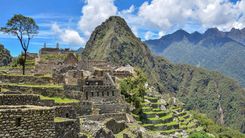21. See the Rainbow Mountains
Vinicunca, also known as Rainbow Mountain, is known for its colorful mineral bands that stripe the slopes at high altitude. These colors were revealed only recently as snow and ice began to melt at the summit.
Getting there involves a long drive from Cusco—about three hours each way—followed by a steep hike that starts at over 14,000 feet (4,300 meters) and climbs to over 17,000 feet (5,200 meters). Most people visit as part of a guided day trip that includes transport, meals, and oxygen if needed. Make sure you’re well acclimatized before attempting the trek. The views are worth the effort, but the altitude is no joke.
How to get to Rainbow Mountains
Getting to the Rainbow Mountains from Cusco is a long but doable day trip. Most tours involve a 3-hour drive each way, followed by a 2–3 hour hike at over 16,400 feet (5,000 meters). Tour companies usually handle transport, breakfast, and lunch and carry oxygen just in case.
If you want a slightly different angle or fewer people, you can also approach the trail from Pitumarca. Doing it on your own is possible, but you'll need a 4WD vehicle and solid experience hiking at high altitudes—it’s not a casual stroll.
When to visit Rainbow Mountains
The dry season, from May to September, is your best bet for clear views and safer trails. Most tours leave Cusco early—around 4 or 5 AM.
During the rainy season, the trail gets muddy, and the colors are harder to see. No matter when you go, spend a few days acclimating in Cusco first. This hike is at serious altitude and can be a rough time if you’re not prepared.
























